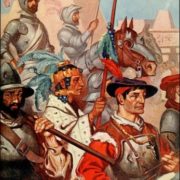A City of Dreams Tenochtitlan / Mexico City 1511
Spanish conquistador (invader) Hernán Cortés and his small troop of soldiers first approached Tenochtitlan, the island capital of the Aztecs, on November 8, 1511. As one of his soldiers, Bernal Diaz, wrote, “…we saw so many cities and villages built in the water and other great towns on dry land and that straight and level Causeway going towards Mexico, we were amazed and said that it was like the enchantments they tell of in the legend of Amadis, on account of the great towers and temples and buildings rising from the water, all built of masonry. And some of our soldiers asked whether the things that we saw were not a dream.” In 1511, an estimated 250,000 to 350,000 people lived in Tenochititlan and its suburb Tlatelolco, which was five times the population of London at that time. The Aztecs were ultimately defeated not by the strife within Mexico or by the guns and swords of the Spanish soldiers, but primarily by the smallpox germs carried by one of the Spanish slaves.
El conquistador / invasor español Hernán Cortés y su pequeña tropa de soldados se acercaron por primera vez a Tenochtitlán, la capital de la isla de los aztecas, el 8 de noviembre de 1511. Como escribió uno de sus soldados, Bernal Díaz, en el agua y otros grandes pueblos de secano y esa calzada recta y llana que va hacia México, nos quedamos asombrados y decimos que era como los encantamientos que cuentan en la leyenda de Amadis, a causa de las grandes torres y templos y edificaciones. surgiendo del agua, todo construido de mampostería. Y algunos de nuestros soldados preguntaron si las cosas que vimos no eran un sueño ”. En 1511, se estima que 250.000 a 350.000 personas vivían en Tenochititlan y su suburbio Tlatelolco, que era cinco veces la población de Londres en ese momento. Los aztecas fueron finalmente derrotados no por la lucha dentro de México o por las armas y espadas de los soldados españoles, sino principalmente por los gérmenes de la viruela que portaba uno de los esclavos españoles.

